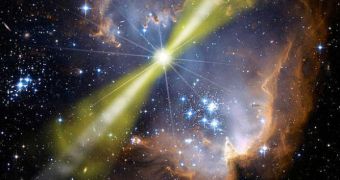Gamma-ray bursts (GRB) are among the most peculiar phenomena in the Universe. Their sources are not very well known, although some evidence exists of possible origins. Since they were first discovered, some 50 years ago, they have sparked excitement in the scientific community, and have made astronomers believe that studying them may result in a deeper knowledge of the Universe. But, as modern-day technology makes it easier to observe them, GRB seem to present more problems than they answer, Technology Review reports.
These emissions are made up of highly energetic photons, the same elementary particles that make up visible light, as well as infrared and ultraviolet radiation. The bursts contain so much light, that some experts believe known astrophysical phenomena cannot explain them, with the bursts being collimated in some way. Within a matter of seconds, these events release about as much energy as the rest of the mass of our Sun. It is now believed that GRB may have played an important part in our planet's history too.
Some scientists say that such bursts were responsible for the five extinction events that nearly wiped all life off the face of the planet. This means that the rays could do that again, and are, therefore, something that needs to be studied and understood. The only condition that needs to be met in order for the radiation to cause us damage is for it to occur in the Milky Way, which is never known to have happened in the past. That's not to say it didn't, just that astronomers haven't found proof of this yet.
The amazing new wealth of knowledge on gamma rays was brought forth by two things. The most important was the launch of dedicated spacecraft that study the phenomenon, such as the Swift observatory (2004), and the Fermi Gamma Ray Telescope (2008). The second innovation is the implementation of a global coordination project, in which astronomers that detect GRB alert the international community. Other teams at other locations can then use their instruments to analyze the afterglow of the burst, and determine where it came from, as well as other properties.

 14 DAY TRIAL //
14 DAY TRIAL //